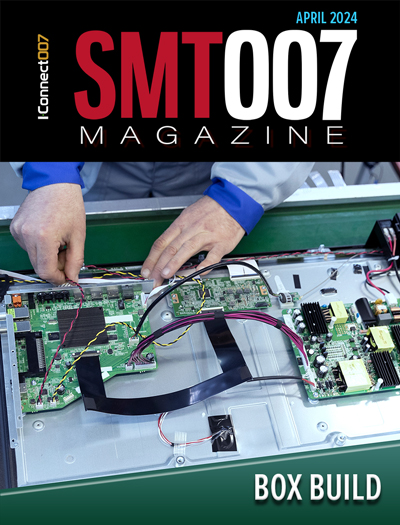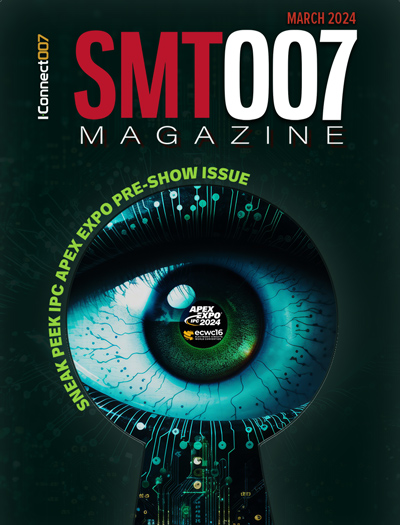-

- News
- Books
Featured Books
- smt007 Magazine
Latest Issues
Current Issue
Box Build
One trend is to add box build and final assembly to your product offering. In this issue, we explore the opportunities and risks of adding system assembly to your service portfolio.

IPC APEX EXPO 2024 Pre-show
This month’s issue devotes its pages to a comprehensive preview of the IPC APEX EXPO 2024 event. Whether your role is technical or business, if you're new-to-the-industry or seasoned veteran, you'll find value throughout this program.

Boost Your Sales
Every part of your business can be evaluated as a process, including your sales funnel. Optimizing your selling process requires a coordinated effort between marketing and sales. In this issue, industry experts in marketing and sales offer their best advice on how to boost your sales efforts.
- Articles
- Columns
Search Console
- Links
- Events
||| MENU - smt007 Magazine
How Far Does It Make Sense to Automate?
May 17, 2016 | Michael Hansson, Integrated Micro-Electronics Inc.Estimated reading time: 2 minutes
For an EMS provider, it is a given that the front-end board assembly process needs to be automated. Regarding the back-end final assembly process, however, the situation is often less clear. There are often many advantages to automating the final assembly process, but how far does it make sense to automate? Is a fully automated process better than a semi-automated, or partially manual process?
Advantages of Automation
Let’s start by reviewing some of the advantages of an automated final assembly process. First of all, an automated process is much more repeatable and will thus allow a much higher quality level to be attained. Today’s requirements for the assembly of automotive-grade electronics require a hands-off approach to handling, with robots and automated handling preferred by most tier 1 customers and OEMs.
In addition to improvements in quality, we can expect a reduction in the total cost of a project—assuming that the volumes are relatively high. Savings come from a reduction in the cost of non-quality, which includes the cost of analysis, inspection, scrap, education, training, field returns and loss of reputation. Furthermore, an automated solution frequently takes up less floor space than a manual process. Flexible automation can be designed to be utilized for multiple programs thus reducing the cost per individual project further. Finally, with the ability to provide an automated final assembly process, an EMS provider can typically attract higher value-add projects that it otherwise would not have been considered for.
Personally, I do not think that automation will lead to a mass displacement of human workers. There will always be new goods that need to be manufactured. The stations that will be automated first will be those where more critical process steps are executed, allowing production operators to fill in the gaps where automation is not needed or cannot be justified. There will always be new goods with shapes, materials, or even in quantities, where automation will not be possible nor practical. The more equipment we put in place on our production lines, the more designers, technicians, programmers and integrators will be needed.
Almost half of the world’s global manufacturing output came from Asia in 2013. Somebody once asked me if I thought that Asian electronics manufacturers are heading for full automation or partial automation. I think such considerations will be made by project rather than by geography. High-volume manufacturing of high-quality products will see more automation than projects with lower volume requirements, higher mixes or lower quality requirements.
Editor's Note: This article originally appeared in the May 2016 issue of SMT Magazine.
Suggested Items
Real Time with… IPC APEX EXPO 2024: Plasmatreat: Innovative Surface Preparation Solutions
04/25/2024 | Real Time with...IPC APEX EXPOIn this interview, Editor Nolan Johnson speaks with Hardev Grewal, CEO and president of Plasmatreat, a developer of atmospheric plasma solutions. Plasmatreat uses clean compressed air and electricity to create plasma, offering environmentally friendly methods for surface preparation. Their technology measures plasma density for process optimization and can remove organic micro-contamination. Nolan and Hardev also discuss REDOX-Tool, a new technology for removing metal oxides.
Real Time with... IPC APEX EXPO 2024: Advancements in Laser Depaneling with LPKF
04/24/2024 | Real Time with...IPC APEX EXPOJake Benz, LPKF sales manager for North America, discusses the company's advancements in laser depaneling. LPKF has introduced a green wavelength laser for processing rigid FR-4 circuit boards, bringing significant gains in processing speeds to market. The company transitioned from IR CO2 to UV wavelength due to heat and burning issues.
Hentec/RPS Publishes an Essential Guide to Selective Soldering Processing Tech Paper
04/17/2024 | Hentec Industries/RPS AutomationHentec Industries/RPS Automation, a leading manufacturer of selective soldering, lead tinning and solderability test equipment, announces that it has published a technical paper describing the critical process parameters that need to be optimized to ensure optimal results and guarantee the utmost in end-product quality.
IPC Design Competition: On Your Mark, Get Set, Go!
04/10/2024 | Andy Shaughnessy, Design007 MagazineI recently spoke with IPC’s Patrick Crawford, manager of design standards and related industry programs, and Kris Moyer, certified IPC master instructor, about this year’s IPC Design Competition. Now in its third year, the preliminary heat began in January, and the winners will compete in the final heat at IPC APEX EXPO in Anaheim.
DRAM Manufacturers Gradually Resume Production, Impact on Total Q2 DRAM Output Estimated to Be Less Than 1%
04/10/2024 | TrendForceFollowing in the wake of an earthquake that struck on April 3rd, TrendForce undertook an in-depth analysis of its effects on the DRAM industry, uncovering a sector that has shown remarkable resilience and faced minimal interruptions.


